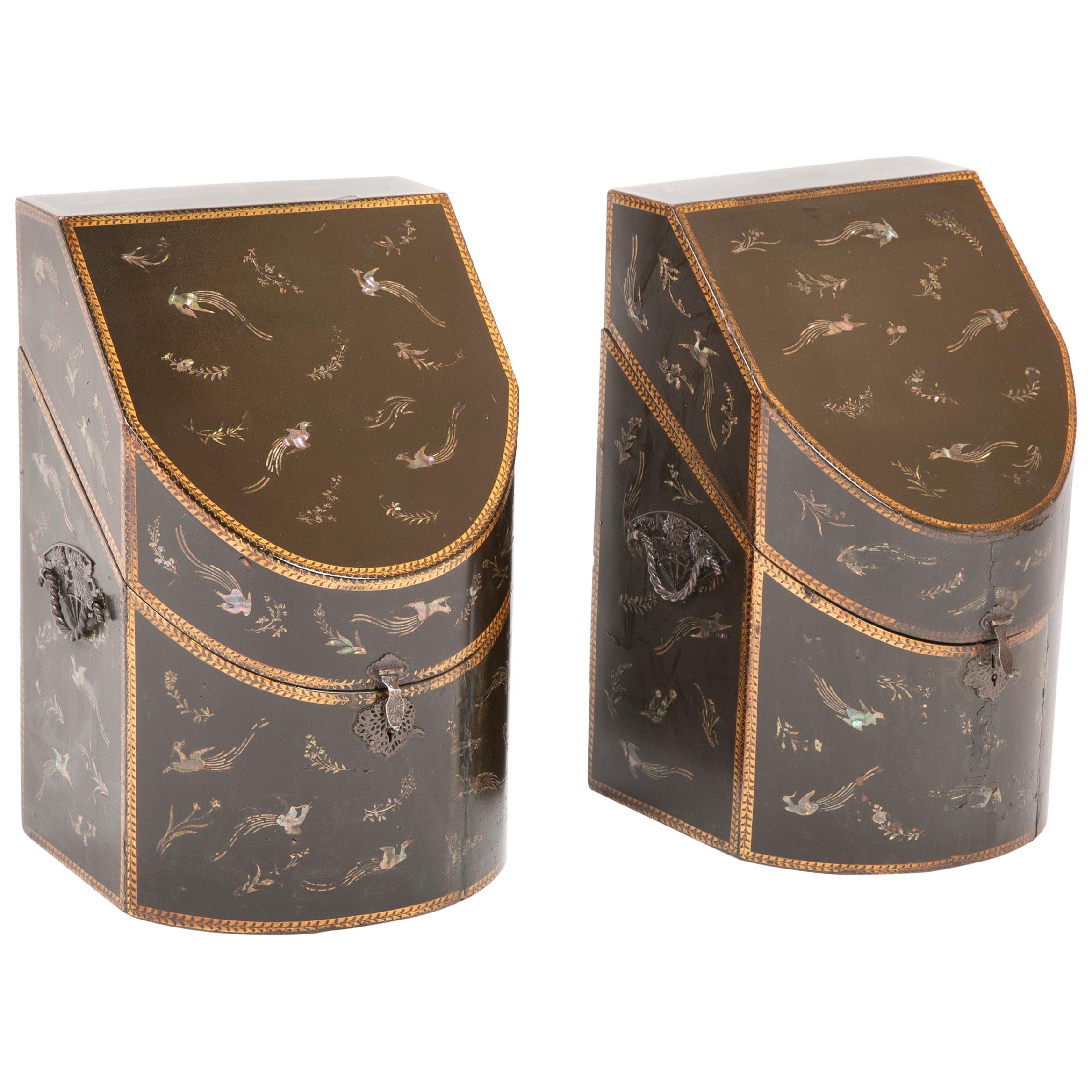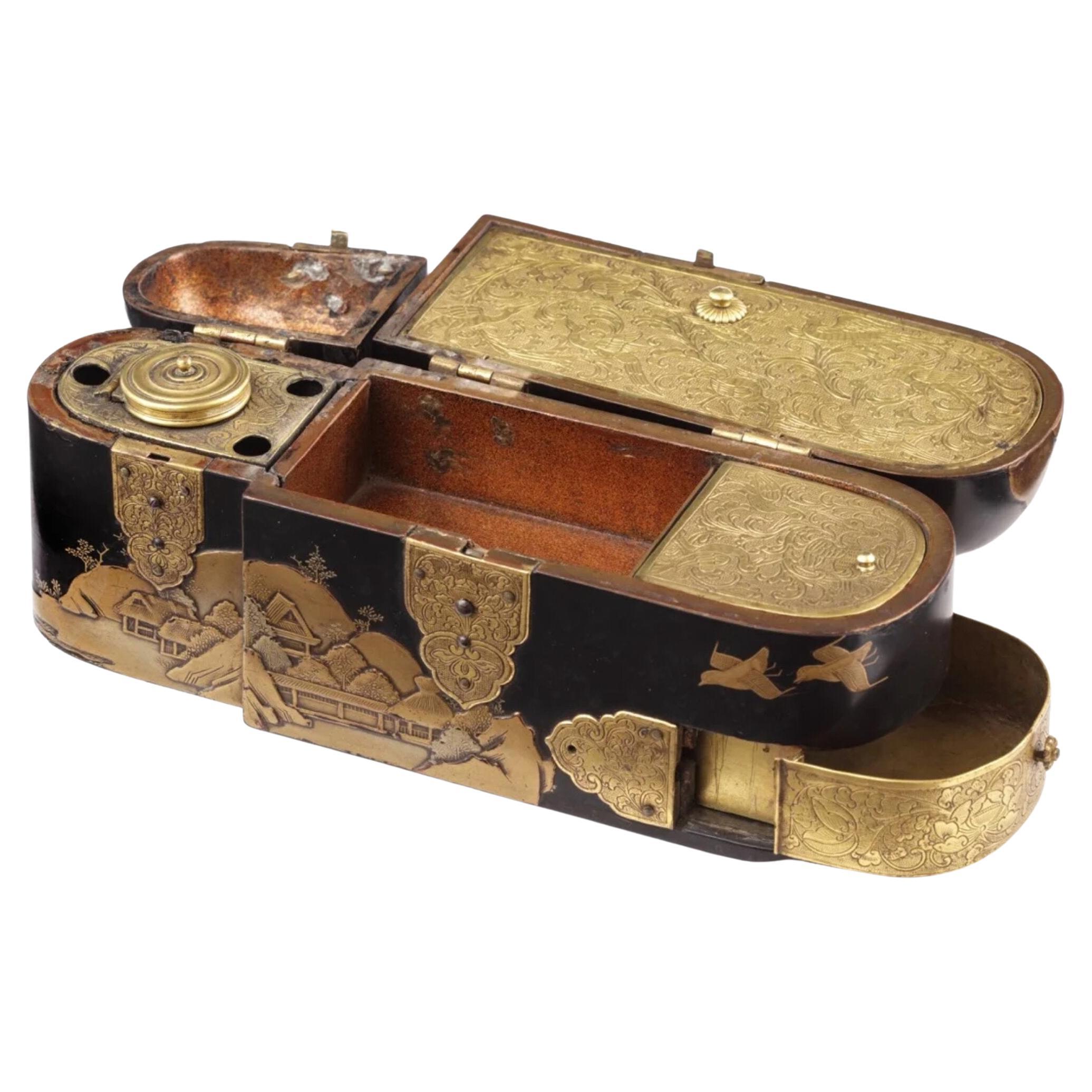Items Similar to Pair of Fine Japanese Export Lacquer Cutlery Knife Boxes, 18th Century
Want more images or videos?
Request additional images or videos from the seller
1 of 5
Pair of Fine Japanese Export Lacquer Cutlery Knife Boxes, 18th Century
About the Item
A pair of fine Japanese export lacquered cutlery boxes
Kyoto or Nagasaki, late 18th century
H. 33.5 x W. 24 x D. 21 cm
The bow-fronted boxes with sloping lids flat at the top are made of hinoki wood (Cypress), coated with Japanese paper and decorated in lacquer with scattered gold birds and flowers on a nashiji background. The Japanese mounts are made of copper and both boxes still have internal partitions to keep the cutlery upright.
The form of these boxes is similar to a pictorial-style knife box in the collection of the Groninger Museum (inv. 1989- 347), dated between 1730 and 1780, but the style of the decoration is more like that on a knife box in the Peabody Essex Museum in Salem (inv. E62271), which was brought to Salem by James Devereux, Captain of the Franklin, in 1799.
Provenance:
Henriette Jeane Christine van Neukirchen, called Nyvenheim (1807- 1849) and Nicolaas Johan Steengracht van Oostcapelle (1806-1866), thence by descent to the last owners, Ludolphine Emilie baronesse Schimmelpenninck van der Oye (1944) married in 1969 to Roland Daniel van Haersma Buma (1944), the last residents of castle Duivenvoorden near Voorschoten and the great-great-granddaughter of Nicolaas Johan Steengracht van Oostcapelle.
There is no evidence that Nicolaas Johan himself, or any of his or his wife’s ancestors had ever been in Japan. However, Nicolaas’ grandfather (Nicolaas Steengracht, 1754-1840) was a director of both the VOC and WIC (West Indies Company) Chambers of Zeeland in Middelburg is known to have collected Chinese porcelain and Japanese lacquer work, so presumably, Nicolaas’ grandfather asked a captain sailing to Deshima or a VOC official on Deshima to order these two cutlery boxes in Japan.
- Dimensions:Height: 13.19 in (33.5 cm)Width: 9.45 in (24 cm)Depth: 8.27 in (21 cm)
- Materials and Techniques:
- Place of Origin:
- Period:
- Date of Manufacture:1780-1800
- Condition:Wear consistent with age and use.
- Seller Location:Amsterdam, NL
- Reference Number:1stDibs: LU5458229650932
About the Seller
5.0
Vetted Seller
These experienced sellers undergo a comprehensive evaluation by our team of in-house experts.
Established in 1985
1stDibs seller since 2020
19 sales on 1stDibs
Typical response time: 3 hours
- ShippingRetrieving quote...Ships From: Amsterdam, Netherlands
- Return PolicyA return for this item may be initiated within 7 days of delivery.
More From This SellerView All
- Pair of Japanese Lacquer and Mother-of-Pearl Inlaid Knife Urns, circa 1800-1815Located in Amsterdam, NLA rare pair of Kyoto-Nagasaki style lacquer and mother-of-pearl inlaid knife urns Edo period, early 19th century Measures: Height 71 x diameter 30 cm ?Formed as urns with vertically lifting covers and elongated finials, revealing fitted green velvet lined interiors for knives, decorated overall with birds, flowering stems, faux-fluting and oval panels with landscapes. The square plinth is raised on four bracket feet. Inside the lifting cover of one of the urns are Japanese characters, supposedly indications of some code by the craftsman. A closely related knife urn, now in the collection of the Peabody Essex Museum, Salem (inv. E 73115), was acquired in Nagasaki by Captain Samuel Gardner Derby of the Margareth of Salem in 1801. Captain Gardner Derby traded in Nagasaki under charter from the VOC (Vereenigde Oostindische Compagnie), the Dutch East India Company. Between 1797 and 1814 Holland was occupied by the French and from 1811 until 1816 Java by the English. During these periods practically no Dutch shipping was possible between Holland and Batavia (Jakarta) or between Batavia (Jakarta) and Nagasaki. To maintain a minimum amount of shipping between Batavia (Jakarta) and Nagasaki, between 1797 and 1807, the VOC chartered mainly American ships. American captains and officers ordered and bought mainly lacquered furniture in an American-English style, completely different from what the Dutch up till then had ordered. The present knife urns were possibly also ordered and acquired by Captain Gardner Derby during his stay in Deshima/Nagasaki in 1801. Another similarly neoclassical shaped knife urn in the collection of the Ashmolean Museum Oxford (inv. 1996.17) appears to be signed by woodworker Kiyotomo koreo tsukuru (Kiyomoto made this). The same name, together with an address in the Sanjo-Teramachi District of Kyoto, has been found inside a fragmentary urn in a private collection. This is an indication that European-style furniture was not only lacquered in Japan but made there as well. This undoubtedly is not only true for knife-urns, but all European- style furniture lacquered in Japan after circa 1800 was made by Japanese furniture makers...Category
Antique Early 19th Century Japanese Anglo-Japanese Lacquer
MaterialsBrass
- Rare 17th Century Japanese Export Lacquer Medical Instrument BoxLocated in Amsterdam, NLA rare Japanese export lacquer medical instrument box Edo-period, 1650-1700 L. 19 x W. 6 x H. 8.5 cm This unconventionally shaped lacquer b...Category
Antique 17th Century Japanese Edo Lacquer
MaterialsGold
- Fine Japanese Export Red Lacquer Box with Masonic Symbols, circa 1800Located in Amsterdam, NLA fine Japanese export red lacquer box with Masonic symbols Kyoto/Nagasaki, 1800-1820 Red lacquer decorated with scattered flowers and flying birds with long tails in gold, wit...Category
Antique Early 19th Century Japanese Edo Lacquer
MaterialsGold
- Fine 17th Century Japanese Export Black and Gold Lacquered Pictorial-Style DishLocated in Amsterdam, NLA fine Japanese export black and gold lacquered pictorial-style dish Nagasaki or Kyoto, 1680-1720 The dish with wide flat rim of Keaki wood (Zelkova species) in black lacquer with...Category
Antique 17th Century Japanese Edo Lacquer
MaterialsGold
- Extremely Fine and Rare 17th-Century Japanese Export Lacquer and Inlaid CabinetLocated in Amsterdam, NLAn extremely fine and important Japanese lacquer cabinet with gilt-copper mounts for the European market Edo period, late 17th century The pictorial style decorated rectangular...Category
Antique Late 17th Century Japanese Lacquer
MaterialsBrass
- Japanese Nagasaki Export Lacquer Box with Depiction of the 'Trippenhuis'Located in Amsterdam, NLA Japanese Nagasaki export lacquer box with mother-of-pearl depiction of the Amsterdam ‘Trippenhuis’ Edo-period, circa 1830 H. 12.5 x W. 24 x D. 15 cm ? The house depicted on t...Category
Antique 19th Century Japanese Edo Lacquer
MaterialsMother-of-Pearl, Lacquer
You May Also Like
- Rare pair of Japanese Nagasaki Export Lacquered Wood Knife BoxesLocated in Stamford, CTRare pair of Japanese Nagasaki Export lacquered wood knife boxes with mother-of-pearl inlay of flowers and birds, now converted to letter boxes. The boxes were converted to letter b...Category
Antique Early 19th Century Japanese Anglo-Japanese Knife Boxes
MaterialsWood
- Antique 18th Century Export Chinese Lacquer Gaming BoxLocated in Brea, CAAntique 18th century export Chinese lacquer gaming box with hand painted scenes gilt export black lacquer, there are 7 gaming boxes and 12 trays, size: ...Category
Antique Late 18th Century Chinese Qing Lacquer
MaterialsLacquer
- Japanese Lacquer Writing Box, Suzuribako, Edo Period, 18th Century, JapanLocated in Austin, TXAn exceptionally fine and unusual Japanese lacquer writing implements box, suzuribako, in the form of a zither, koto, Edo Period, 18th century, Japan. With a modern wood storage box,...Category
Antique 18th Century Japanese Edo Lacquer
MaterialsGold, Silver, Copper
- 18th Century Japanese Lacquer Writing Box and Tray SetLocated in Hudson, NYWheels Submerged in flowing water motif, believed to be a subject popular in samurai families. Example of the same subject matter in Tokyo National Museum.Category
Antique 18th Century Japanese Lacquer
- Fine Japanese Lacquer Suzuribako 'Inkstone Box'Located in PARIS, FRBlack and gold maki-e and hirame-ji lacquer box representing a branch of plum tree in bloom which is entangled in a low wall, highlighted by mother-of-pearl inlay (raden). Inner cover made of nashi-ji lacquer with mizuhiki threads and folds. These are elements, made of silk and washi paper, supposed to bring luck and happiness, intended to seal envelopes on the specifics events (gift, new year, birth, marriage, death, etc.). Shape and color of the threads vary according to the occasion celebrated and the desired meaning. Interior in nashi-ji lacquer, with water cup...Category
Antique Late 19th Century Japanese Lacquer
MaterialsLacquer
- Japanese Samurai Abumi Stirrups Lacquer Edo, 18th CenturyLocated in Dallas, TXJapanese Samurai Abumi Stirrups lacquer Edo late 18th century, early 19th century. Measures: 12 inch length, 10 inch height, 5.5 inch width. AVANTIQUES is dedicated to providing an...Category
Antique Late 18th Century Japanese Edo Lacquer
MaterialsIron
Recently Viewed
View AllMore Ways To Browse
Pair Lacquer
Pair Of Lacquer
Fine Art Pairs
Lacquer Company
The Lacquer Company
Gilt Lacquer Wood
Lacquered Wood Gilt
Lacquered Copper
Japanese Company
Fine China Japan
Japanese Fine China
Wood Lacquered Box
18th Century Gold Box
Chinese Gilt Lacquer
Pair Wood Boxes
Chinese Lacquer And Gilt
Knife Box
Chinese Export Lacquer





